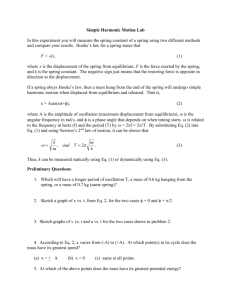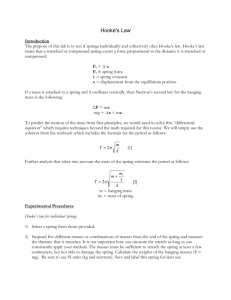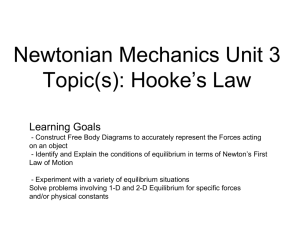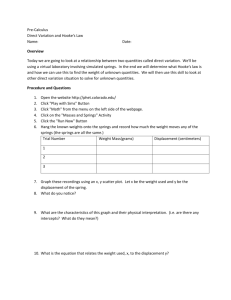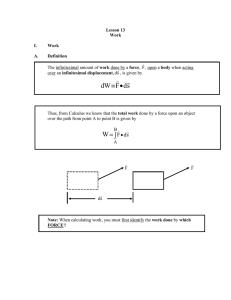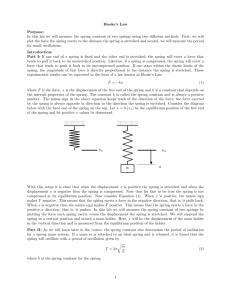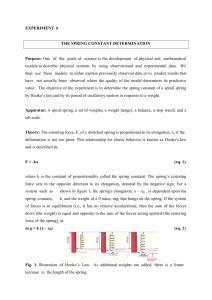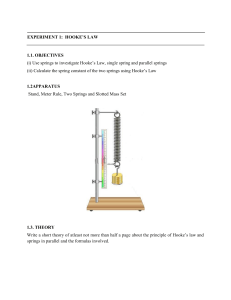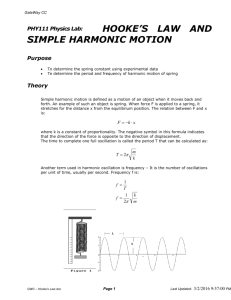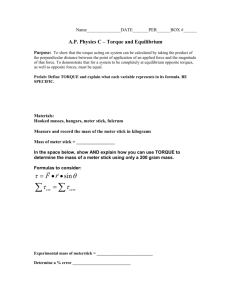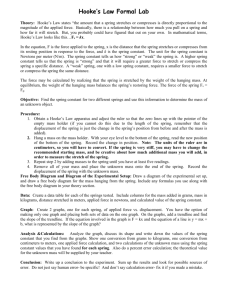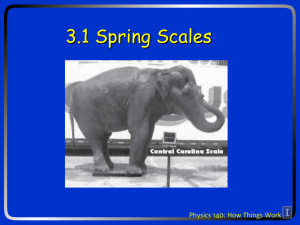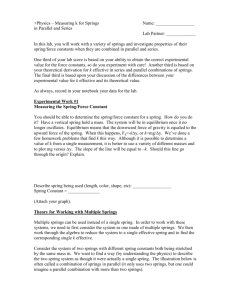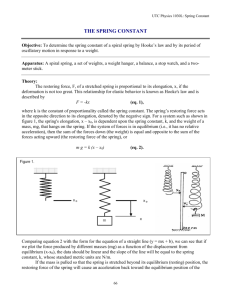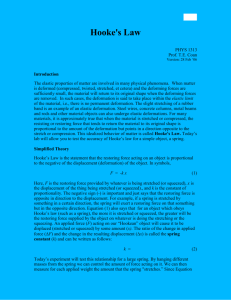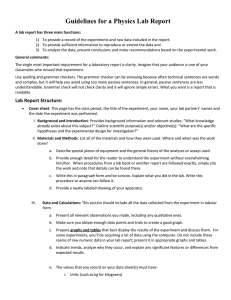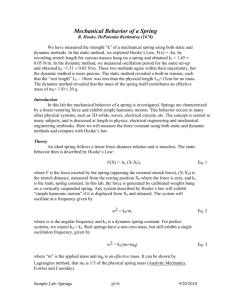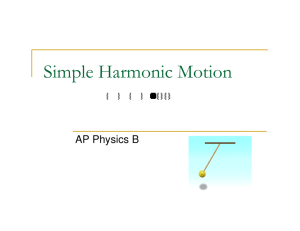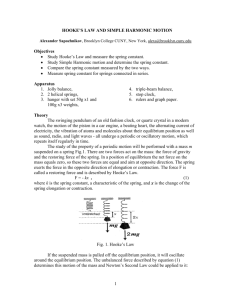Experiment #6 Hooke`s Law and the Work done by a Spring
advertisement
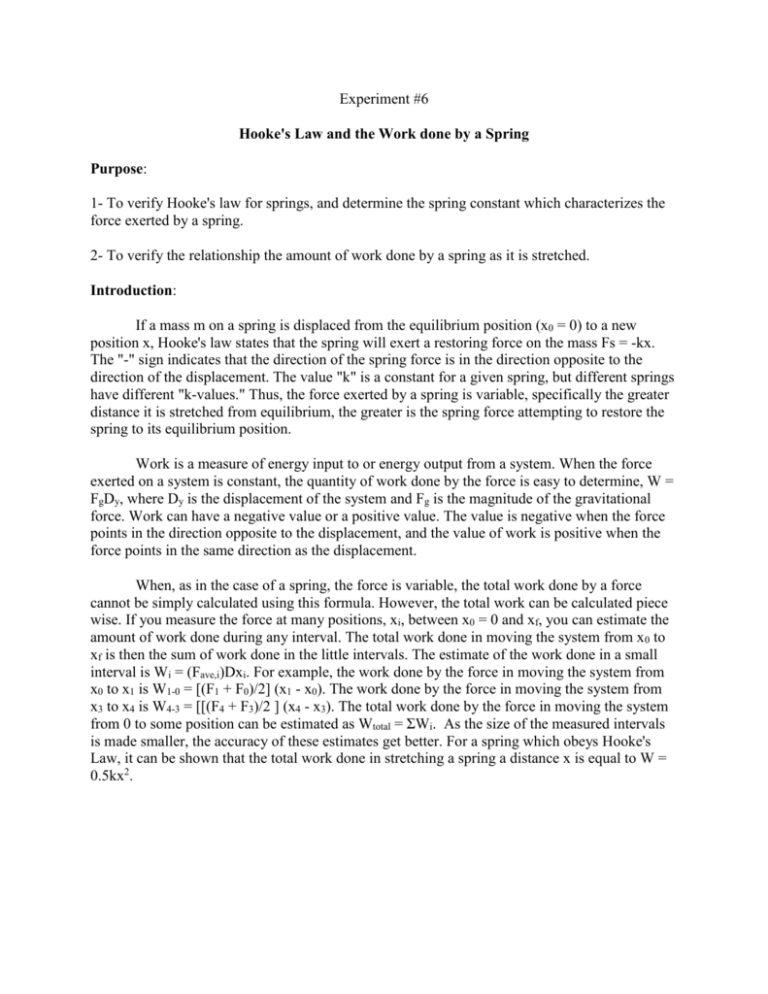
Experiment #6 Hooke's Law and the Work done by a Spring Purpose: 1- To verify Hooke's law for springs, and determine the spring constant which characterizes the force exerted by a spring. 2- To verify the relationship the amount of work done by a spring as it is stretched. Introduction: If a mass m on a spring is displaced from the equilibrium position (x0 = 0) to a new position x, Hooke's law states that the spring will exert a restoring force on the mass Fs = -kx. The "-" sign indicates that the direction of the spring force is in the direction opposite to the direction of the displacement. The value "k" is a constant for a given spring, but different springs have different "k-values." Thus, the force exerted by a spring is variable, specifically the greater distance it is stretched from equilibrium, the greater is the spring force attempting to restore the spring to its equilibrium position. Work is a measure of energy input to or energy output from a system. When the force exerted on a system is constant, the quantity of work done by the force is easy to determine, W = FgDy, where Dy is the displacement of the system and Fg is the magnitude of the gravitational force. Work can have a negative value or a positive value. The value is negative when the force points in the direction opposite to the displacement, and the value of work is positive when the force points in the same direction as the displacement. When, as in the case of a spring, the force is variable, the total work done by a force cannot be simply calculated using this formula. However, the total work can be calculated piece wise. If you measure the force at many positions, xi, between x0 = 0 and xf, you can estimate the amount of work done during any interval. The total work done in moving the system from x0 to xf is then the sum of work done in the little intervals. The estimate of the work done in a small interval is Wi = (Fave,i)Dxi. For example, the work done by the force in moving the system from x0 to x1 is W1-0 = [(F1 + F0)/2] (x1 - x0). The work done by the force in moving the system from x3 to x4 is W4-3 = [[(F4 + F3)/2 ] (x4 - x3). The total work done by the force in moving the system from 0 to some position can be estimated as Wtotal = ΣWi. As the size of the measured intervals is made smaller, the accuracy of these estimates get better. For a spring which obeys Hooke's Law, it can be shown that the total work done in stretching a spring a distance x is equal to W = 0.5kx2. Procedure: 1. Measure the mass ms of the spring. 2. Determine the range of mass values that you will investigate. The range of masses should correspond to a wide range of spring extensions. Please don't overstretch the spring. 3. By hanging mass M on the spring and reading the position of the mass hanger against a meter stick, you are going to determine the spring constant k. Be sure to use SI units. It is up to you to decide how many different values of M to use, and by how much to increase M for each measurement. The mass of the hanger is included as part of M. Note that there is no y value for M = 0, and that the origin of the meter stick has no particular meaning. These are not real problems, for reasons given below. However, you should not move the meter stick after you start making measurements! 4. Make a graph of Fg (vertical axis) vs. y (horizontal axis). [Fg = Mg for the spring when it is in equilibrium.] Determine the slope of your best line through the data. This slope should correspond to the spring constant k in N/m. Note that the slope does not depend on where you placed the origin of the meter stick. Also note that your first few data points might not be on a straight line. If this is the case, you may ignore these points in drawing your best line. 5. Take a different type of spring. Stretch it a little to get a feel for the strength of the spring. Do the same for the first spring you measured. Starting in step 6 you will make measurements of the force in the second spring. But first, make a prediction of what you expect to find. What will the graph of Fg vs y look like for the second spring relative to the first spring? How will the spring constant of the second spring compare to the spring constant of the first spring? Be sure to identify which spring is which with a clear description of the two springs. 6. Repeat steps 1 through 4 for the second spring. 7. Compare your results with your predictions. What does the spring constant tell us? What are the characteristics of springs with large spring constants compared to those springs with small spring constants? 8. For one spring, calculate the work done by the gravitational force as it stretched the spring. Do this by first estimating the work done by the force between successive measurements of the force and then by adding together these individual contributions to the total work. Compare this value to the predicted by the relationship W = 0.5kx2.

